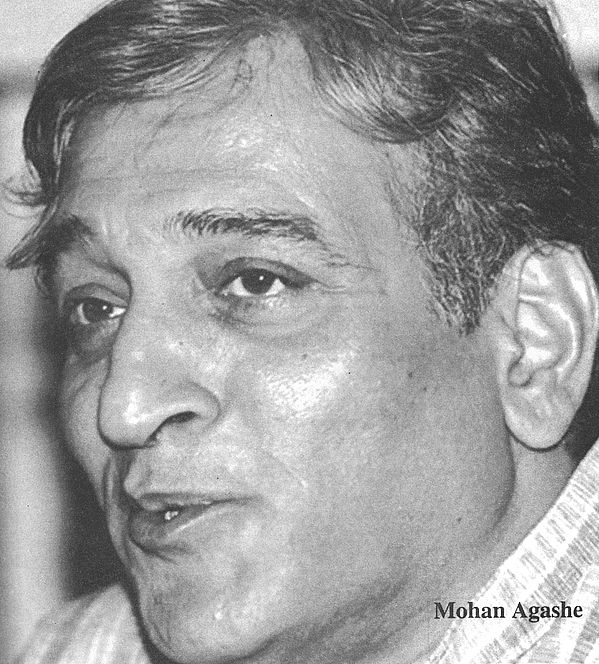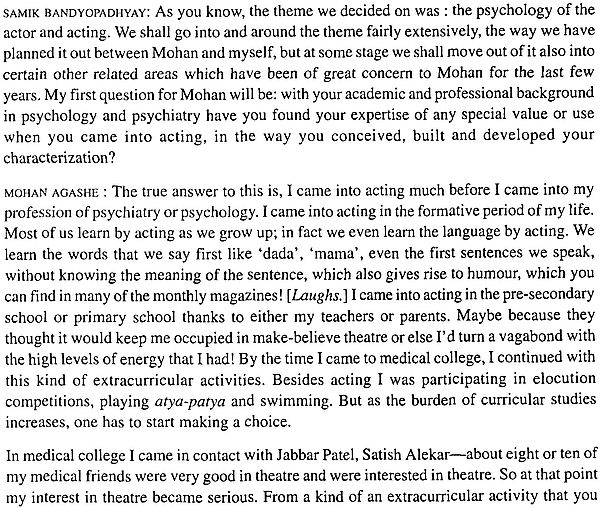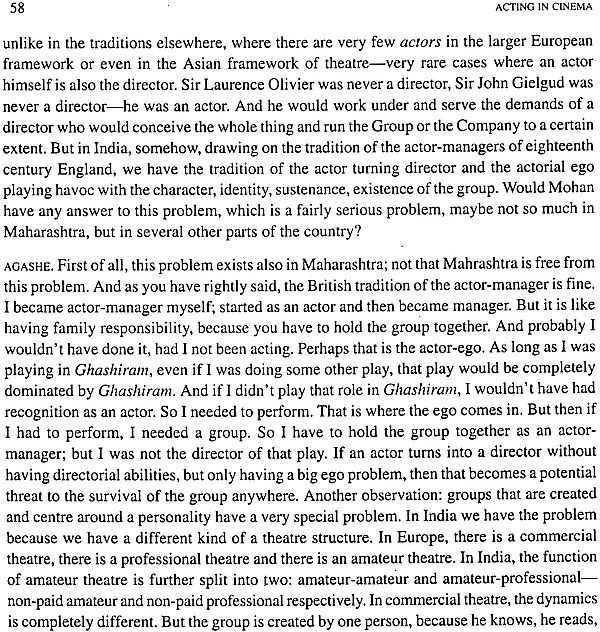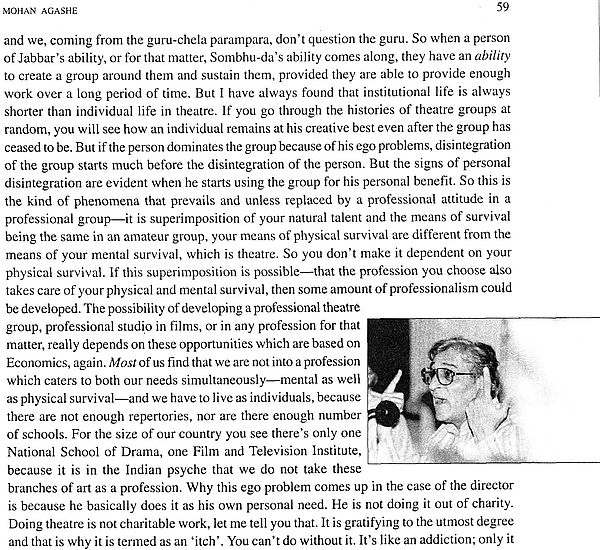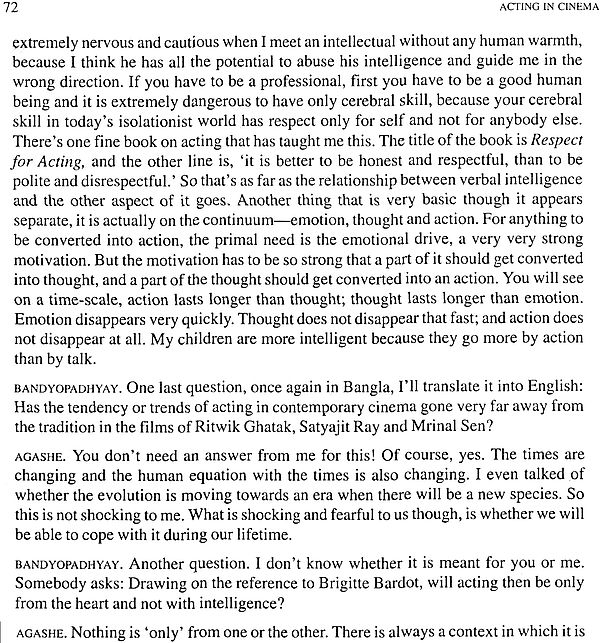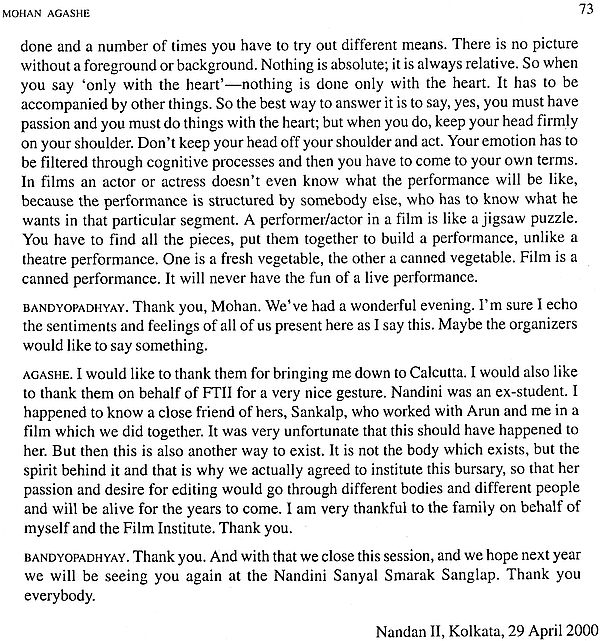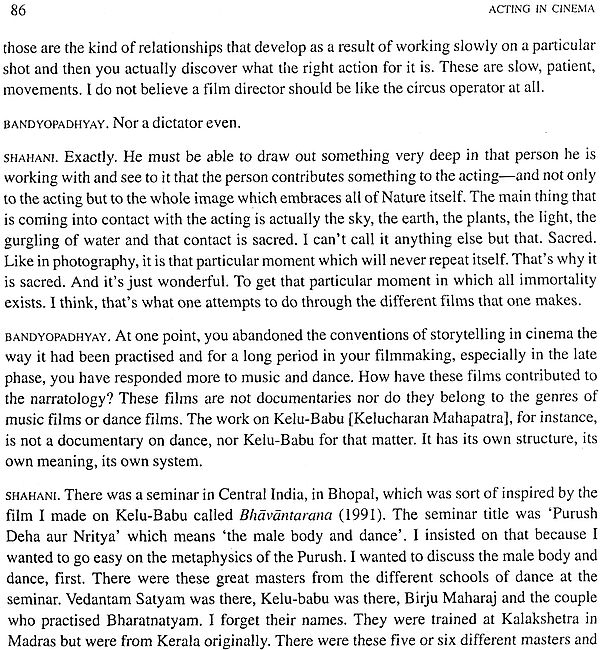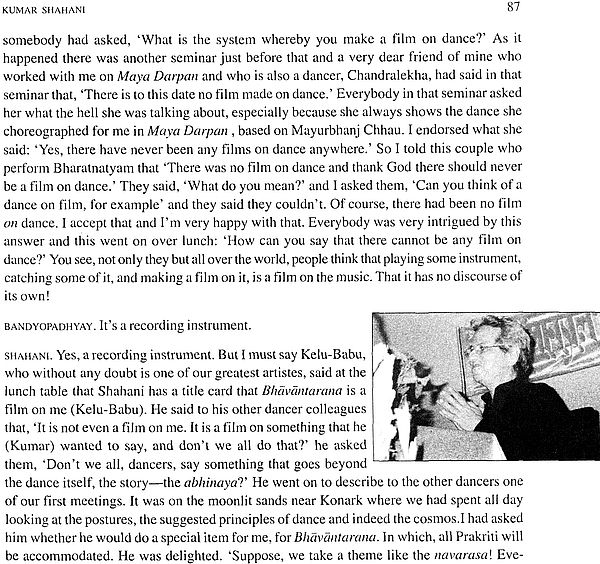
ACTING IN CINEMA: The Nandini Sanyal Memorial Lectures 1999-2002
Book Specification
| Item Code: | IDF561 |
| Author: | Soumitra Chattopadhyay, Mohan Agashe & Kumar Shahani |
| Publisher: | Thema Books, Kolkata |
| Language: | English |
| Edition: | 2004 |
| ISBN: | 8186017534 |
| Pages: | 94 (B & W Illus: 23) |
| Cover: | Paperback |
| Other Details | 8.1" X 7.5" |
Book Description
About the Book:
Nandini Sanyal (1968-98), with a Masters in geology, opted for the profession of film editing, after training at the Film and Television Institute of India, Pune. She was barely thirty when she was killed in a railway accident that brought a promising career to a premature end.
The Nandini Sanyal Memorial Lectures, instituted in her memory propose to draw filmmakers and film viewers together into a series of public dialogues on different aspects of cinema, allowing for several contentious issues to be addressed and explored and may be even clarified in the process.
The first Three in the series, collected in this volume, centre round acting in cinema from different perspectives, as experienced and defined by an eminent stage and screen actor, an actor who is also a professional psychiatrist and a film director. In the first part of each of these Lectures the main speaker is interviewed by and arts and media critic; in the following part he answers questions from an invited audience.
About the Authors:
SOUMITRA CHATTOPADHYAY made his film debut in Satyajit Ray's Apur Sansar (1959), and continues as one of India's most distinguished actors on stage and screen with landmark appearances in Ray's Charulata, Days and Nights in the Forest, Branches of a tree, and his Feluda films; Mrinal Sen's Akashkusum; Tapan Sinha's Atanka and Wheelchair; and Gautam Ghosh's Dekha. He is a poet in his own right, and has translated adapted, directed and performed in plays for the stage.
MOHAN AGASHE is a practicing psychiatrist, and a widely popular actor on stage and screen, with outstanding stage appearances in the internationally acclaimed theatre productions, Ghashiram kotwal and Begum Barve, and film roles in Satyajit Ray's Sadgati and M F Husain's Gajagamini.
KUMAR SHAHANI led the New Wave in Indian cinema with his Maya Darpan, followed by major works like Tarang and Char Adhyay. A Homi Bhabha Fellow, hehas made significant contributions to film theory.
Throughout the eighties and into the nineties in Kolkata, there was a fresh surge of enthusiasm, activity and animated discussion around ‘good’ cinema-the goodness measured by different parameters by different players in the field, covering films with clear messages on or documenting human problems; films become significant only when one when one has cracked the code embedded in their obscure technique; the film classics; and of course films representing the new waves within the country and abroad. The trend as such was not entirely new. But what the new generation brought to it was a passion that emboldened them to reject the professional choices offered by an extremely by an extremely competitive market, and opt for the uncertain prospects of the profession of filmmaking. They felt a compulsion to step beyond the safe and limited role of a viewer and plunge into the challenge of making films.
Nandini Sanyal (1968-98) was part of this generation. Born into an economically comfortable, highly educated middle class family of south Kolkata, she graduated in geology, but then abandoned the academic route with a Masters in geology in 1991, to join the diploma course in filmmaking offered by the Film and Television Institute of India at Pune, specializing in film editing, Before her trip to Pune, she had nurtured and cultivated her interest in cinema at Chitrabani, a Jesuit media studies at Kolkata, and through lively interactions with the young film enthusiasts who thronged the portals of Nandan, the film centre run by the Government of West Bengal. Her urge to leave all this behind and choose a more directly creative role for herself must have developed out of the knowledge and inspiration that she had gathered in the process.
Once she had completed her FTII course, she went on to assist several distinguished film directors on their projects, including Char Adhyay, directed by Kumar Shahani. When she was killed in a railway accident at a suburban station close to Mumbai in the early hours of 15 October 1998, she was already engaged in a busy round of professional assignments as a fullfledged film editor, moving from studio to studio.
Nandini 's creative endeavour and professional commitment constituted a departure from the more common involvement in films evident in the Bengali middle class, an involvement confined to watching films at matinee and evening shows, and rarely at a night show. Her utterly shocked and heartbroken family had to come to terms with this terrible loss before they could resolve to institute the Nandini Sanyal Memorial Lectures as their contribution to the evolving culture of good cinema in India, a cause that Nandini had cherished and tried in her own way to further.
The Lectures are designed as dialogues, conceived in terms of a number of series; each series of three devoted to a particular aspect of cinema providing for a publication of the transcripts at the completion of the particular series. The format of such a dialogue, with a main speaker initially in conversation with a critic, eventually opening up to answering questions/reactions from the audience, allows for a focused and yet wide enough critical interaction between filmmaker and film viewer.
The first three lectures that constitute the first series were devoted to acting in cinema. The three speakers, Soumitra Chattopadhyay for 1999, Mohan Agashe for 2000, and Kumar Shahani for 2002, spoke out of different bodies of exposure and experience, as well as positions and attitudes. Chattopadhyay, best known for his performances in so many of Satyajit Ray's films, and internationally acclaimed and honoured as an actor, offered a rich personal survey of acting in Bengali theatre and cinema from the fifties till now, to construct a model for the ideal relationship/interaction between director and actor in the making of a film. Agashe, professionally a psychiatrist, and actor, and theatre administrator, went into the psychological impulses and pressures and motivations that made an actor live and behave and act the way he/she does. Shahani's reading of the role of the actor in cinema, and particularly in the style that defined his own films, was strikingly and challengingly different.
The transcripts, now collected as a volume, offer rich insights into and perspectives on acting in cinema born out of the practice in which the speakers have been engaged. But they cannot quite convey the individual tones and styles that marked their presentations, holding their audiences in fascinated attention-Chattopadhyay's rich intonation, Agashe's dramatics, and Shahani's quiet confidence, and all with their distinctive touches of humour.
There are individuals who are merely letters of an alphabet, there are those very few who become sensational news. There are many of a different breed altogether-those who slowly shape into news through their deeds, their creative endeavours. Nandini Sanyal-whom we lovingly called Papu-was shaping into news through her work, when she was suddenly struck down by an accident and turned into a shocking piece of news of a kind that we had never envisaged. Members of her family and those who knew her closely have come together to form a Nandini Sanyal Smarak Committee. Since cinema was her first and ulti-mate love, the Committee has resolved to hold every year a seminar or a dialogue centring on cinema, but drawing into its purview anything that is related to or involved in cinema, e.g. music, theatre, acting or the visual arts. The theme chosen for this evening's session, the first of the series, is: Acting in Cinema, Acting in Theatre. For interlocutors in this dialogue, we have two individuals who have over several years been implicated in this discourse anyway-Soumitra Chattopadhyay, equally original and innovative as actor in both theatre and films, as poet and playwright and director; and Samik Bandyopadhyay, widely known to this audience as theatre and film critic. I have the pleasure of inviting them to engage in a dialogue that would enrich us, this gathering of lovers of theatre and cinema.
SAMIK BANDYOPADHYAY. This evening we would aim at unravelling and bringing to the surface the notions and convictions that Soumitra Chattopadhyay has discovered and imbibed through his experiences over a long acting career. We have seen a rich line of performances on stage and screen, and with all those at the back of our minds and stored in our memory, often with striking details, we would be searching for those ideas and impressions that lie buried at the very roots of those performative expressions. That will be the motivation for the way I frame my questions, and I am sure fresh questions will be thrown up by the answers he gives us. At the very beginning of his acting career, in theatre, not in cinema, Soumitra Chattopadhyay had the privilege of knowing closely the legendary actor, Sisirkumar Bhaduri [1889-1959], who offered him a reference point, a litmus test for acting at its best. Some of us, who came to know the great Bhaduri, for a much shorter while, around the same time, when, banished from Srirangam, the last regular theatre where he had performed, he was left without a theatre of his own, found him still trying, with unwavering commitment, in the midst of utter frustration and helplessness, to convey to whoever cared to listen a rare sense of theatre, a distinctly original underpinning for acting. The glimpses of a creative mind that we could gather have remained inspiring enough. But with his much closer and longer association with Sisirkumar, I am sure Soumitra-da would have a far richer perception to share with us of his knowing Sisirkumar, and of observing the acting tradition of the time, with Sisirkumar as the point of reference.
SOUMITRA CHATIOPADHYAY. I was lucky in one respect, I must say. When I finished school, and moved to college, I came to settle in Kolkata. Whenever I have gone back in time, I have found that phase in my life one of utmost importance. I came to live in a metropolis like Kolkata at a time a growing individual finds all the windows opening out before him. Till then I had lived in small towns, moving from place to place with my father who got posted at different towns. On my arrival in Kolkata, along with my first exposure to a whole range of activities, political and cultural, I got abundant opportunity to watch theatre in Kolkata. As I was telling you, I consider myself particularly lucky since the first theatre that I watched in Kolkata happened to be the theatre of Sisirkumar Bhaduri. I was sixteen or seventeen when I first saw him act, my very first experience of his presence, and it was something really indescribable. For whoever has seen Sisirkumar perform-there should be several present here, including Samik himself-the first impact would be mind-blowing; for it would blow away at once all the accumulated mannerisms and terrible cliches of the other trends current in the Bengali theatre of the time. It was therefore a matter of great fortune that the first theatre I saw in Calcutta was Sisirkumar's, and at once I could cherish him from the very beginning as my ideal for acting, especially stage acting. Once I had started watching him, I realized that only a handful of the fifty-six or fifty-eight productions that he had mounted over a career of thirty years in theatre, continued to be performed. The rest had gone out of his repertoire for ever. There were about eight or ten in all that went on being staged. I made a point of watching each of them as many times as many times as I could. Then in 1956 his theatre company folded up, and he had to give up his theatre. But meanwhile I had perhaps learnt from him once I had come into personal association with him, of what acting is all about. But there was no scope any longer of checking out on all that I had heard or read about his role as a producer from those who had watched his work in the past or from the book Sisirkumar O Bangla Rangalay [‘Sisirkumar and the Bengali Theatre’, Kolkata 1954] by Hemendrakumar Roy [1888-1963], or from accounts left behind by Abanindranath Tagore [1871-1951] and Rabindranath. For the theatre was in a sorry plight then, and the sets somehow fixed together were nothing to write home about. All that survived so extraordinarily in the midst of all that poverty was his acting, and that of some of the rest in the company which still had a couple or so of tolerably competent actors, for by then most of the better known actors had left the company. But what Ifound striking was that it came through clearly enough that all of them had been thoroughly trained by Sisirkumar, they all performed to the discipline of a harmonious style; it had what we would call exemplary teamwork. The first team of actors with which Sisirkumar had made his appearance in theatre included outstanding actors of the calibre of Manoranjan Bhattacharya [1889-1954] and Jogesh Choudhury [188-1942], and great actresses like Prova Devi [1903-52] and Kankabati Devi [1903.39]. With actors like Biswanath Bhaduri [1897-1945], Shital Pal and Sailen Choudhury [1897-1946], it must have been one of the strongest companies ever. But when I came to watch Sisirkumar perform, the old company was no longer there. Only a few of the lesser actors were still there, but what was remarkable was that Sisirkumar could achieve, even with these actors, the homogeneity of performance that he desired
